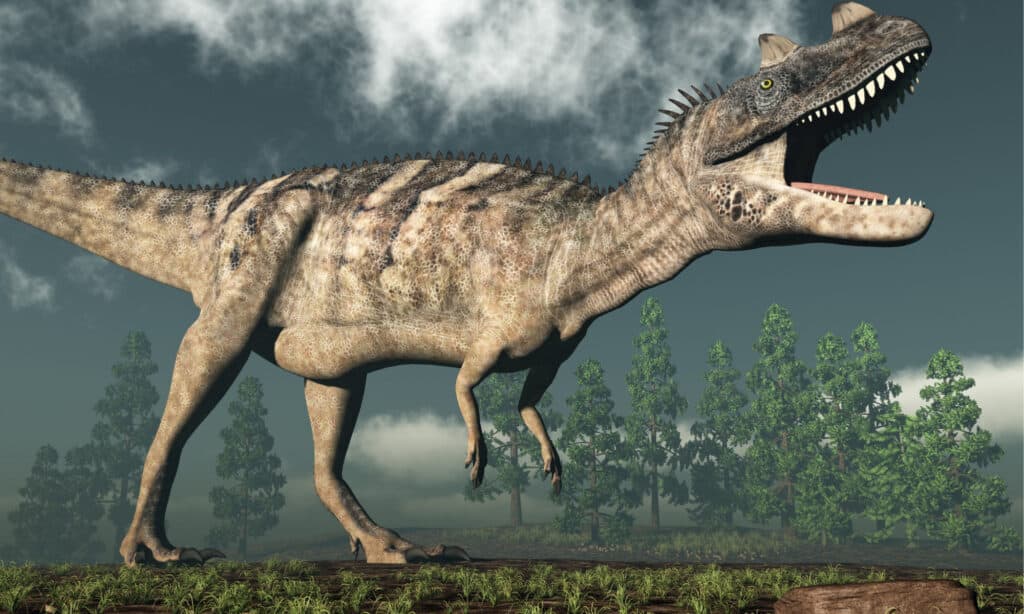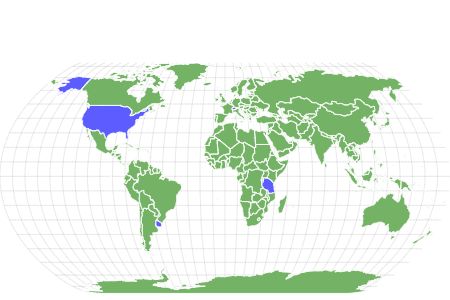Ceratosaurus
Ceratosaurus nasicornus
Advertisement
Ceratosaurus Scientific Classification
- Kingdom
- Animalia
- Phylum
- Chordata
- Family
- Ceratosauridae
- Genus
- Ceratosaurus
- Scientific Name
- Ceratosaurus nasicornus
Read our Complete Guide to Classification of Animals.
Ceratosaurus Conservation Status
Ceratosaurus Facts
- Biggest Threat
- Injury, illness, and competition for food
- Most Distinctive Feature
- A horn made of bone behind its nostrils
- Distinctive Feature
- Deep jaws with large teeth designed to tear into meat
- Diet
- Carnivore
- Favorite Food
- Scientists don't know for sure, but probably fish, crocodiles, and other dinosaurs
- Special Features
- Armor-like bones along its back
- Location
- Western US, Portugal, possibly Africa
View all of the Ceratosaurus images!
The Ceratosaurus was a Therapod: a dinosaur characterized by hollow bones and three toes and claws on each limb.

©
It’s not often that a complete dinosaur skeleton is discovered, telling scientists and researchers so much about a new species so quickly. But that’s exactly what happened when paleontologist Othniel Charles Marsh discovered the Ceratosaurus in 1884. Learn more about this fearsome carnivore that lived during the Late Jurassic Period along with other well-known dinosaurs.
Ceratosaurus Classification and Scientific Name
Ceratosaurus actually refers to the genus of the species Ceratosaurus nasicornus. This dinosaur was part of the Theropoda clade and is commonly referred to as a Theropod. Theropod dinosaurs had hollow bones and three toes on each of their feet. There were a lot of Theropods throughout the Cretaceous Period until the extinction of the dinosaurs 66 million years ago. Even some modern-day bird species are descended from ancient Theropods.
The name ceratosaurus means “horned lizard.” The complete taxonomy of Ceratosasurus shows how it fits into the larger dinosaur and animal groups.
Ceratosaurus Classification
| Kingdom | Animalia | |
| Phylum | Chordata | |
| Clade | Therapoda | |
| Family | Ceratosauridae | |
| Genus | Ceratosaurus | |
| Species | Ceratosaurus nasicornus |
The type species is C. nasicornus, but it is believed that there were two other species: C. dentisulcatus and C. magnicornis.
Description and Size
Ceratosaurus was a mid-sized dinosaur for its time. It was between 17 and 25 feet long, based on specimens discovered. It was likely around 1,000-2000 pounds. Scientists discovered many complete fossils of Ceratosaurus, helping them understand its description and size. The first discovered specimens may have been younger dinosaurs because they were smaller than the ones found later.

©iStock.com/MR1805
This dinosaur walked on two legs and had three toes on each foot. This is one key feature that classifies it as a Theropod. It had front arms, although they were considerably smaller and it did not use them to walk. Its back legs were very large and powerful, helping it run. The Ceratosaurus hunched over and leaned forward as it walked. Because of this, it stood a bit shorter than its overall length.
Like many other Theropods, Ceratosaurus had a large head relative to the rest of its body. Compared to its small arms, the large head was almost comical. It had deep jaws with large teeth that were made to tear into meat. It also had a horn made of bone behind its nostrils. This was a helpful feature that allowed scientists to make reconstructions of what Ceratosaurus may have looked like while it roamed the earth.
Similar to modern-day birds, Ceratosaurus had a fused pelvis and fused metatarsus, some of the bones in the foot. Scientists were further able to identify Ceratosaurus fossils and how they differed from other similar dinosaurs by examining these fused bones. It also had armor-like bones along its back.
Ceratosaurus likely had a good sense of smell, based on fossils that showed how their olfactory bulbs were shaped and sized. They were smaller than the Tyrannosaurus rex, however, which is known for its above-average sense of smell.
Diet
Ceratosauruses were carnivores. This means that they ate only meat. They had large, sharp teeth and powerful jaws. Their teeth were particularly long compared to other carnivores, such as the Allosaurus, that lived in the same location at the same time. This may have meant that they hunted different kinds of prey or fed on different parts of the carrion.
These fast dinosaurs could run after their prey. While scientists don’t know exactly what they ate, they were one of the larger carnivores in their environment. This meant that they had plenty of options when it came to dinner. They may have even eaten aquatic species, such as ancient fish and crocodiles.
Ceratosauruses probably ate other dinosaurs as well. These may have included herbivores and even the young or weak of other carnivore species.
Habitat

.
©Daniel Eskridge/Shutterstock.com
Ceratosaurus lived during the Late Jurassic Period, around 153-148 million years ago. Fossils of the Ceratosaurus have been found in the western United States, many in the large Morisson Formation. There is also evidence that it lived in what we now call Portugal.
These carnivores lived alongside other well-known carnivores, including Allosaurus. Fossils show that they lived at the same time and in the same locations. One of the reasons that both types of dinosaurs were able to survive is that they may have fed on different parts of the same prey.
Other fragments have been discovered in Uruguay, Tanzania, and Switzerland, which puzzles scientists. Most do not believe there is enough evidence to confirm Ceratosaurus actually lived in all these areas.
Threats And Predators
These dinosaurs were some of the larger carnivores during the Jurassic Period. They may not have been as big as T. rex, which lived during the Cretaceous Period, but Ceratosaurus was still formidable and didn’t have too many predators.
Other carnivorous dinosaurs, such as the Allosaurus, might have preyed on young or weak Ceratosauruses. They probably didn’t seek them out as food. However, when a small or weak Ceratosaurus was around, other carnivores probably took advantage of such a convenient meal.
Injury, illness, and competition for food were likely bigger risks for Ceratosauruses. Researchers believe that the horns on the top of their heads were used by male dinosaurs when competing for mates. Injuries from these horns could have posed a major threat for the Ceratosaurus.
Young Ceratosaurus
Paleontologists believe that all dinosaurs, including Ceratosaurus, reproduced by laying eggs. During this time, Ceratosaurus was probably vulnerable to predators. Young Ceratosaurus could have been prey for other carnivorous dinosaurs.

Ceratosaurus fossils were first discovered in 1884 in the Morrison Formation in Garden Park, Colorado.
©iStock.com/Elenarts108
Discoveries and Fossils
The first Ceratosaurus was discovered in the Morrison Formation, a large rock formation in the western United States. In 1884, Othniel Charles Marsh found it in Garden Park, Colorado. It led to the discovery and classification of a brand new dinosaur species. Because this specimen was so complete, scientists learned that it was a distinct species separate from Allosaurus.
Portugal also has many Ceratosaurus fossils. The Lourinha Formation, named for the Lourinha region of Portugal, is a well-known site of Late Jurassic Period fossils. These include Ceratosaurus and Allosaurus.
Ceratosaurus fossils are rare. There are not as many compared to the plentiful Allosaurus, which lived at the same time. Due to their bony horn, however, Ceratosaurus fossils are very easy to recognize. This is especially true for complete specimens. You can even see a complete Ceratosaurus skeleton at the Natural History Museum of Utah.
Additional fragments found in the same areas led some scientists to think that there may have been multiple species of Ceratosaurus. However, now most think that they are just fossils of C. nasicornus at different points in the life cycle. Some fossils have been identified as young Ceratosauruses.
Scientists initially classified some fragments in Tanzania, Uruguay, and Switzerland as Ceratosaurus. However, they now believe that they belong to other dinosaur species. There is no evidence that Ceratosaurus lived outside of the areas that are now the western U.S. and Portugal.
Extinction
Ceratosauruses lived during the Late Jurassic Period. Researchers do not know exactly why or when these dinosaurs went extinct. But fossils from later periods did not include any specimens of Ceratosaurus. It is possible that competition for food with other dinosaurs that lived at the same time made it impossible for a large enough population to survive and reproduce.
Similar Animals to The Ceratosaurus
Other Theropods lived during the same time as well as later into the Cretaceous Period. These dinosaurs include
- Allosaurus: The main competition for resources with Ceratosaurus, the Allosaurus was also a Theropod that lived during the Late Jurassic Period. Allosaurus fossils are often found near Ceratosaurus, leading scientists to believe that the two species lived in the same places at the same time. Allosaurus was larger and there are more fossils, which makes it a better-known dinosaur overall.
- T. rex: The King of the Dinosaurs lived much later than Ceratosaurus. T. rex lived during the Cretaceous Period, around 90 to 66 million years ago. They were much larger than Ceratosaurus but had a similar body structure and were also carnivores.
Ceratosaurus FAQs (Frequently Asked Questions)
When did Ceratosaurus live?
The Ceratosaurus was alive during the Late Jurassic Period, around 153-148 million years ago. While scientists do not know why or when it went extinct, fossils of the Ceratosaurus all place this dinosaur during the Late Jurassic.
How big was a Ceratosaurus?
Ceratosaurus was around 1000 pounds and between 17 and 23 feet long from its head to its tail. It walked on two legs and stood a bit shorter than its overall height. They were large dinosaurs for the time, although smaller than the well-known Allosaurus, which also lived during the Late Jurassic Period.
Thank you for reading! Have some feedback for us? Contact the AZ Animals editorial team.
Sources
- Natural History Museum of Utah, Available here: https://nhmu.utah.edu/ceratosaurus-nasicornis
- Natural History Museum, London, Available here: https://www.nhm.ac.uk/discover/dino-directory/ceratosaurus.html
- Marsh discovery, 1884, Available here: http://marsh.dinodb.com/marsh/Marsh%201884%20-%20Principle%20characters%20of%20American%20Jurassic%20dinosaurs,%20Part%20VIII,%20The%20Order%20Theropoda.pdf

















